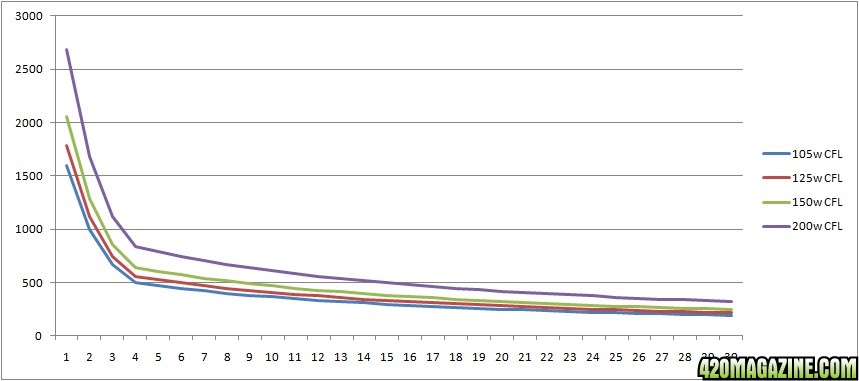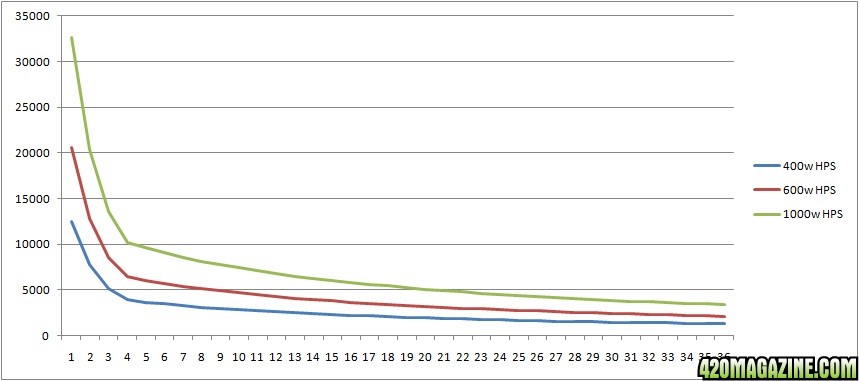I see a lot of folks asking about light and a lot of folks testifying about their light setups. I recently picked up a light meter. It's a cheap one that measures foot candles. A light meter is the only definitive measure of the light level on your plants. I very useful tool. I'd like to explain that and try to answer a few of the recent questions on the thread.
Watts
(Total Watts from all the lights * hours lit ) /1000 = kilowatt hours
A watt is a watt here. The wattage listed on each bulb is a direct measure of its power consumption. Some CFL bulbs are sold with a wattage equivalent in incandescent lighting. This number means nothing to us. If you are replacing incandescent lights (old style light bulbs) then this number would have meaning but it is not a measure of the light or power consumption of the bulb. Every bulb should have its real wattage listed on the bulb. One watt burns one kilowatt hour of power every hour.
Kilowatt_hour
I you have 5 200w CFL bulbs they burn power 1000kwh like a single 1000w HPS light. High levels of power consumption generates heat in the wiring which lowers the conductivity of the wiring and will cause a larger power draw. Using high grade wiring (rated in amps) and spreading out the load you can approach the listed power consumption. This is why folks like the 240 power as it can handle the load with less heat and provides a much larger capacity per circuit. Conversely, if you hook up a whole bunch of CFL lights to a cheap extension cord it will heat and increase the power usage.
Lumens and Foot Candles/Lux
Lumens are a measure of the amount of light that will shine off a bulb. This is number is represents all the light that comes off the entire bulb. Lumens is not a measure of the light hitting your plants. Light is going to shine off a bulb in an area more or less the same shape as the bulb. The thing to remember here is that lumens alone do not determine the light reaching the plants. You need lumens AND coverage area to calculate the light that is shining on a given point in the canopy.
Lux and Foot Candles are a measure of how much light is shining on a given point. I have a light meter that measures in foot candles the high end meters measure Lux. (1 ft candle = 10.74 Lux)
Foot-candle (Lumens / sq ft) = Lux, (Lux/10.74 = ft candles) As the light moves away from the source it defuses exponentially in 360 degrees. The coverage area increases and the light levels drop. The decay looks like this based on the listed lumens from each bulb:
What is really important here is the shape of the curves. You will see this same shape from all bulbs and the sun. I have used my light meter to verify the shape of these curves on CFLs, HPS and LED lights. When I make readings there's always ambient and reflective light. I'm measuring to adjust for hot or cold spots. For example my 600w HPS gives me 4570 ft candles at the top of the plants 12 inches from the reflector. My 125w CFL gives 3740 at the top of the plants 2 inches from the bulb. The 600w light is at 3700 ft cn at 17 inches. The 125w CFL drops below 1000ft candles at 8 inches, the 600w HPS drops that low at 33 inches. 600w has a 21 inch grow zone where the CFL has only 6 inches.
Color Spectrum
I can't measure spectrum nor can I calculate it from the information at hand. Each of my bulbs are rated for Color Temperature.
A measurement, represented in degrees Kelvin, which indicates whether a lamp has a warm or cool color appearance. Warm light sources (2000-3000K) appear more yellow while cool light sources (4000K or higher) feature more light in the blue spectrum. — 1000bulbs.com
I have plenty of testimonials, many on this site, on low red color temperatures being better for flower and high blue better for veg. The absorbed spectrum is central to the ad pitch for LED lights.

This shows that plants absorb the red and blue light and not so much the green. I can't measure the absorption or the spectrum of the light. I did measure an LED light at a local store this weekend with my light meter. It was a 300w array made from 6watt and 5watt bulbs. It gave off 3740 ft candles at 2 inches and 1740 at 4 inches. As I expected the light levels drop fast from the array of small bulbs as the early "spike" in light curve is so short, so short that the bulbs at one end can't really shine all the way to the far end of the panel. I'd guess that it would take a 100% better absorption rate to match the effective grow area a 600w HPS (at half the watts). This exceeds their claims of 80% better which I find unreasonable to begin with. I believe their lights have the spectrum but the the HPS/CFL lights we use are more efficient then the LED vendors claim. I also, conclude that LEDs would be the right choice for some grows. While the coverage area is not as deep, its is flat (the shape of the panel) and the low heat output can save grow space.
My advice, Get a light meter. Power is expensive and its the only way to get real measurements of bulb output, ambient and reflected light in your grow. To get full effect of your lights you need to find the hot and cold spots and adjust the lights and groom the plants to maximize coverage. My meter cost $80 and I think the adjustments I've made using it are already worth the cost.








